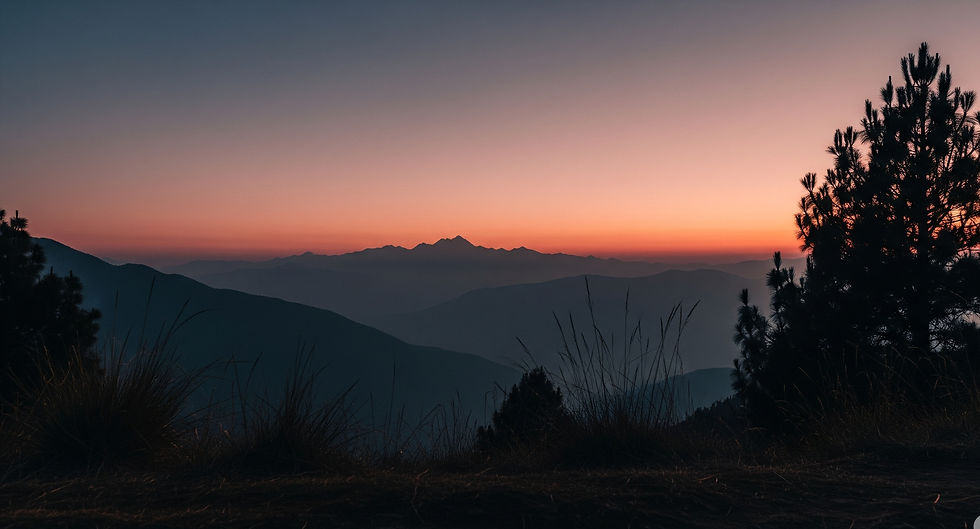What is Special About Kasar Devi in Uttarakhand? A Spiritual Secret
- Glacier Gazette

- May 24
- 4 min read
The first time I heard about Kasar Devi, it wasn’t from a travel brochure or an Instagram reel. It was a quiet evening conversation with a fellow traveler in Rishikesh. He simply said, “There’s a place above Almora that pulls people in—not for the views, but for something...else.” That one sentence lingered with me for months.
When I finally arrived, I wasn’t greeted by grandeur or noise. Just stillness. The kind that speaks louder than any crowd. Kasar Devi, perched above the Kumaon hills, is not a place you visit. It’s a place that meets you. Somewhere between the sky and the soul.
In this article, you will learn:
The unique geomagnetic phenomenon surrounding Kasar Devi.
The temple's rich history and its allure to global spiritual figures.
Why Kasar Devi is considered a hidden gem among global travelers.
Practical tips for visiting and experiencing its tranquil energy.

Twilight at Kasar Devi Ridge: Spiritual Escape to Himalayas
The Mysterious Magnetic Field of Kasar Devi
So, what is special about Kasar Devi in Uttarakhand?
It starts with the Earth itself. According to a NASA study and reports cited by the Indian Institute of Astrophysics, Kasar Devi is located on the Van Allen Belt, a rare magnetic field alignment found in very few places across the globe. The other two well-known sites? Stonehenge and Machu Picchu.
What does this mean for you as a visitor? People report experiencing enhanced meditation, mental clarity, and an unusual calm. Some even say it helps with emotional grounding. This is not just spiritual talk — it’s supported by geomagnetic science.
One traveler I met, a former software engineer from Berlin, said it felt like "his anxiety dissolved into the wind" after just a day on Crank’s Ridge.
If you’re someone who meditates, or even if you simply crave quiet away from the digital noise, this energy field can feel profoundly restorative.
A Temple with History Carved in Silence
The Kasar Devi Temple itself, tucked above Almora town, dates back to the 2nd century CE. Unlike the over-commercialized temples that flood much of northern India, this one doesn’t shout for your attention. It sits there in peaceful defiance, surrounded by deodars, pine, and the whispering winds.
So many spiritual icons have come here, not by invitation, but by inner calling. Swami Vivekananda meditated here in the late 1800s. In his own writings, he described a “rare tranquility” he hadn’t felt anywhere else.
Later came the mystics of the West — poets, thinkers, seekers. Allen Ginsberg, Bob Dylan, and even Timothy Leary were drawn to this silent sanctuary in the '60s. It became part of what was called the "Hippie Trail," but its essence never became a trend.
What makes this history so powerful is that it remains untouched by ego. No souvenir shops boast of their presence. Only pine needles and time hold the memory.
"In the silence of the hills, the loudest truths echo." — Anonymous
Why the World Quietly Whispers About Kasar Devi
To the untrained eye, Kasar Devi looks like any other Himalayan village. A small cluster of cafes. A few homestays. Forest trails that smell of moss and sunlight.
But for those who listen deeply, there’s a subtle magic. Travelers describe strange coincidences here. Artists find clarity. Writers begin books. Burnt-out professionals rediscover their breath. It doesn’t sell itself like Rishikesh or Dharamshala. That’s exactly why it feels more sacred.
Locals believe the place chooses who it reveals itself to. One evening, while sipping pahadi chai, I asked a long-time resident why so many foreigners came here. She smiled, "Because when the world gets too noisy, people look for places that whisper instead."
If you're searching for lesser-known spiritual places in India, Kasar Devi isn’t just a destination — it becomes a gentle companion in your inner journey.
Planning Your Visit: When Stillness Calls
If your heart feels nudged to visit, here’s what you should know:
Best time to visit: October to March is ideal. The skies are clearer, and the serenity is uninterrupted by heavy tourist traffic.
Where to stay: Avoid commercial hotels in Almora. Instead, choose a local homestay in Kasar Devi or Crank’s Ridge. Not only do you support local families, but you also stay closer to the soul of the place.
What to bring: A journal, good walking shoes, and a light mind. There’s no better gear for internal journeys.
Meditation points: The temple complex itself, Crank’s Ridge, and nearby Dol Ashram are all known for deep silence and safe solo reflection.
Connectivity: Mobile networks are patchy. Treat it as a gift. Unplug willingly.
The best thing you can do in Kasar Devi is nothing. Let the place do its work on you.
Not Just a Secret. A Silent Invitation.
Places like Kasar Devi don’t advertise themselves. They don’t have neon signs or global campaigns. But maybe that’s what makes them sacred.
They wait.
They wait for someone who’s tired of the predictable. Someone who seeks stillness more than spectacle. Someone who isn’t looking for another destination, but a small reset of the soul.
And maybe that someone is you.
So, what is special about Kasar Devi in Uttarakhand?
It’s not just the magnetic fields. Or the wandering mystics. It’s the way your breath deepens without trying. The way your mind slows down without guilt. It’s a mirror held up by the mountains to remind you of your own quiet center.
Because the real secret of Kasar Devi? It doesn't change you.
It simply lets you remember who you are.



Comments